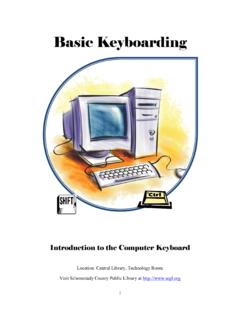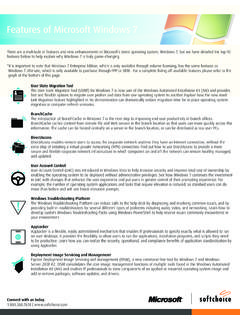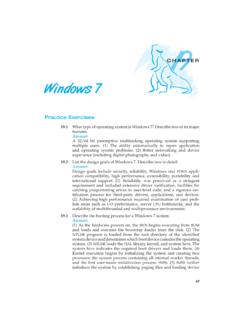Transcription of Windows 7 - SCPL
1 1 Microsoft Office - Windows 7 File Management Location: Central Library, Technology Room Visit Schenectady County Public Library at (The following document adapted from ) 2 Windows Start button What is a desktop? The desktop is the main screen that displays icons and Windows Start button - your virtual desk. The look of your desktop can be changed by applying different properties to it through the control panel. Desktop icons stand for or represent files, folders, and programs that are located on the hard drive of your computer. Taskbar: by default, the taskbar is located on the bottom edge of the desktop. You can click the taskbar and drag it to other locations.
2 The Start button, active program/folder buttons, icons pinned for quick access to programs, and the current time are located on the taskbar. Computer: provides access to the resources on your computer. Internet Explorer: icon launches the Internet Explorer browser. Recycle Bin: when you delete an object, your operating system sends it to the Recycle Bin. You can restore objects located in the Recycle Bin or you can permanently delete them. Program, folder, document icons: represent the actual object and provide direct access to the object. 3 What are drives? Drives are hardware components used to store data. Almost all computers come with at least two drives: a hard drive (for storing large volumes of data) and a CD or CD/DVD drive for storing smaller volumes of data.
3 This drive requires you to insert a disk that you can easily transport from one computer to another. The hard drive is typically designated the C:\ drive, and the CD drive is typically designated the D:\ drive. If the hard drive is partitioned (divided into several parts) or if you have additional drives, the letters E:\, F: \, G:\, and so on are assigned. Flash drives (also called thumb drives or travel drives) are convenient external portal devices for saving your files and folders. What are folders? Folders are used to organize the data stored on your drives. The files that make up a program are stored together in their own set of folders. You will want to organize the files you create in folders.
4 You will want to store the files of a like kind you create in a single folder. What are files? There are three types of files document, program, and data files. A document file includes any file you ve created a text document, sound file, graphical images, or any other type of information the computer can create, store, seize from the Internet. Program files contain instructions for the computer s microprocessor; they tell the computer what to do. Data files include all other files that aren t exactly programs or documents. These include support files for programs and temporary files. Files can be identified by name, size, date and time, type, and icon.
5 For example, a file might be identified as a .doc, .jpeg, or .pdf. Files are given names and saved to a location, such as the desktop or folder in a drive. 4 Exploring Windows 7 Navigation Pane: use to access libraries, folders, saved search, and hard disks. Use Favorites section to open your most commonly used folders and searches; use the Libraries section to access your libraries. Back and forward Buttons: navigate to other folders or libraries you ve already opened without closing the current window. Toolbar: use to change the appearance of your files and folders, burn files to CD, or perform other common tasks.
6 The toolbar s buttons change depending on what task you are trying to perform. Address bar: use to go to a different folder or library. Library pane: appears only when you are in a library. Use the library pane to customize or arrange features of the library. Column headings: use to change how the files in the file list are organized. File list: contents of current file or folder are displayed. Search box: use to look for a file or folder in the current folder or library. Details pane: use to see the most common properties of the selected file. Properties include file name, creation date, size of file, etc. 5 How do I change Windows 7 views?
7 Windows 7 allows you to change the appearance of your File List pane. Click the drop-down Change Your View icon and select how you want your screen to look. For example, a Large Icons view would look like this: 6 What are Libraries in Windows 7? Windows 7 introduced a set of four Libraries to help you organize the files and folders you create. Documents Library: use for organizing and arranging your word processing documents, spreadsheets, presentations, and other test related files. Files that you move, copy, or save to Documents Library are saved in the Documents folder. Music Library: use for organizing and arranging your digital music.
8 Music files that you move, copy, or save to Music Library are saved in the Music folder. Pictures Library: use for organizing and arranging your digital pictures from your camera, scanner, or e-mail from other people. Picture files that you move, copy, or save to Pictures Library are saved in the Pictures folder. How do I name and save a file? 1. Open new document window. 2. Click on File or disk icon. 7 3. Select the location where you want to save the file. (You may want to create a new folder for the file.) Your computer will default to a Library location OR the previous location where you saved a file. 4. Give the file a name. 5. Consider Save as type file for compatibility.
9 6. Click Save. How do I create a new folder? 8 1. Select (click on) the Library in which you want to create the new folder. 2. Click New Folder on the toolbar. Type a name for the new folder. OR 3. Right-click any free area in the File List pane. A context menu will appear. Left click New. Left -click Folder. Type a name for the new folder. **Remember to periodically backup (save) files/folders to external source such as flash drive, CD, or DVD.** How do I rename a file or folder? 1. Select (click on) the file or folder to be renamed. Click on Organize Rename from the toolbar. A pulsing textbox with cursor will appear. Type in the new name.
10 OR 2. Right-click the file or folder. A dropdown menu will appear. Left-click Rename. Type the new name. 9 How do I delete a file or folder? To delete a file or folder: 1. Select (click on) the file or folder you want to delete. Click on Organize Delete from the toolbar. OR 2. Right-click the file or folder you want to delete. A context menu will appear. Left-click Delete. You will be asked if you are sure you want to delete the file. Click Yes. How do I copy/cut a file or folder? (Remember to paste file to new location) To copy or cut a file or folder: 1. Select (click on) the file or folder you want to copy or cut.










